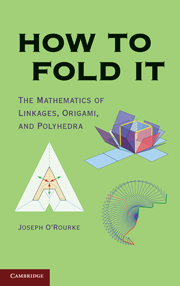4 - Flat Vertex Folds
Published online by Cambridge University Press: 05 June 2012
Summary
Although an origami folding generally produces a 3D object, such as the ubiquitous crane, intermediate stages of the folding are often flat, that is, parallel layers of paper squashed into a plane, as in Figure 4.1. In fact, flat origami as an end-product is its own well-developed art form.
In this chapter, we examine some of the surprising regularities present in flat origami, and then touch on the perhaps even more surprising technical unknowns lurking in a problem as commonplace as folding a map.
Mountain and Valley Creases
When you fold a sheet of paper in half, you create a straight-line crease that extends from one edge of the paper to an opposite edge. A crease snaps fibers in the paper, which is why the crease imprint remains after the creasing pressure is released, and why you cannot erase a crease completely by uncreasing – the fibers remain broken. Origami creases need not in general extend from edge to edge of the paper being folded. With some care, you can crease a line segment in the interior of the paper, with neither endpoint at the paper edge.
Creases come in two varieties: those created by a mountain fold and those by a valley fold, with natural meanings; see Figure 4.2. Traditionally, valley folds are indicated in origami diagrams as dashed lines –––––, and mountain folds by a dash-dot pattern, –·–·–·–.
- Type
- Chapter
- Information
- How to Fold ItThe Mathematics of Linkages, Origami, and Polyhedra, pp. 57 - 71Publisher: Cambridge University PressPrint publication year: 2011



